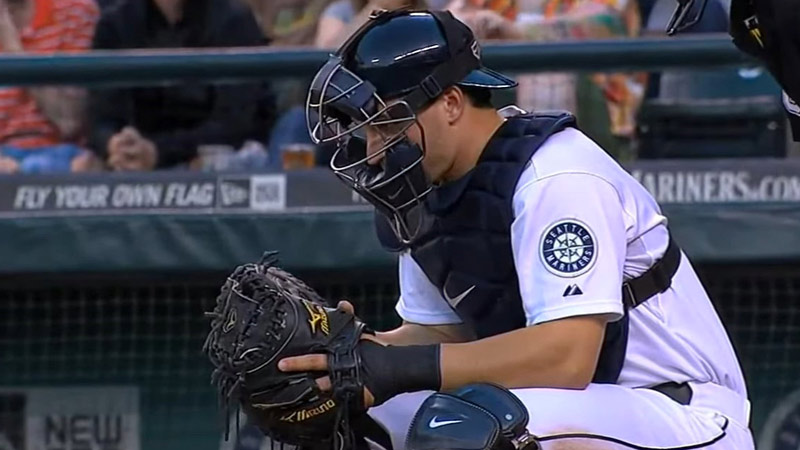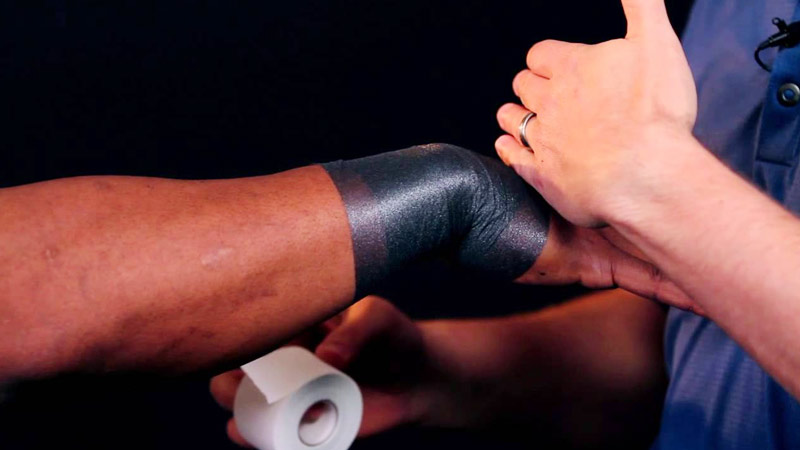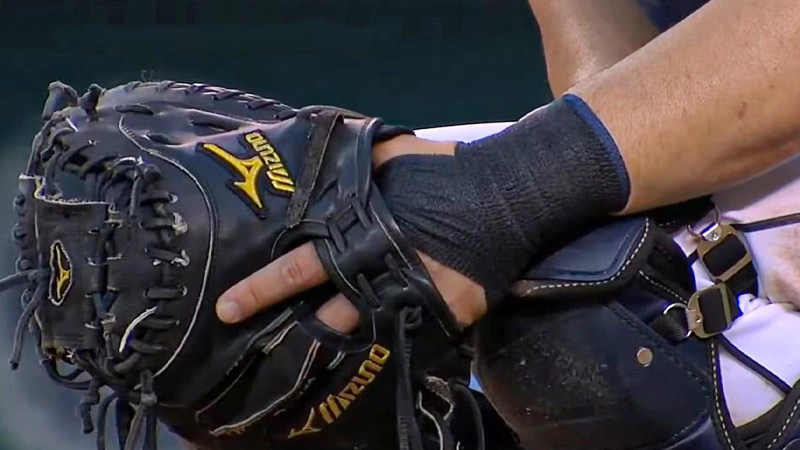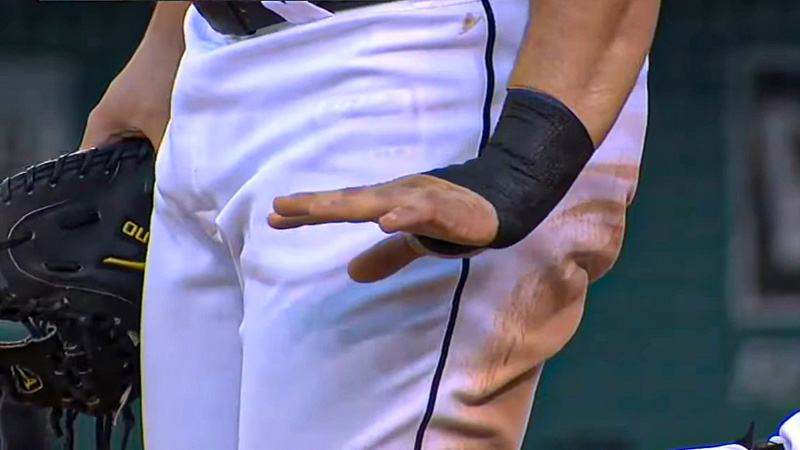Baseball is a game of precision and power, where every movement, from pitching a fastball to swinging a bat, demands impeccable hand-eye coordination and finesse.
To achieve this, baseball players often rely on a time-honored ritual that has intrigued both fans and newcomers to the sport: taping their wrists.
This unassuming practice, which involves the strategic application of various types of tape, plays a pivotal role in the performance and well-being of players on the diamond.
In this blog post, we’ll delve into the intriguing world of wrist taping in baseball. Why do baseball players tape their wrists? How does it impact their gameplay?
By exploring these questions, we aim to shed light on the often-overlooked yet vital aspect of the game.
Whether you’re a dedicated fan or just curious about the world of baseball, this exploration of wrist taping will provide valuable insights into the game’s inner workings. Stay focused.
Why Do Baseball Players Tape Their Wrists?
Baseball players tape their wrists for several reasons. First, it provides support and stability to the wrist joint, which is crucial for various aspects of the game, such as throwing, catching, and swinging a bat.
This added support helps prevent injuries and strains, particularly during high-impact movements.
Additionally, taping the wrist can help players maintain proper wrist alignment, which is essential for control and accuracy in throwing and hitting the ball.
It also offers a level of compression, which may reduce swelling and discomfort in case of minor injuries or existing wrist issues.
Furthermore, many players use wrist taping as a routine ritual or superstition, believing it enhances their performance or provides a psychological boost.
Wrist taping in baseball serves both functional and psychological purposes, aiding in injury prevention and potentially improving a player’s confidence and performance.
The Importance of Wrist Health in Baseball

Wrist health is of paramount importance in baseball, as the wrists play a critical role in various aspects of the game.
Here are some key points highlighting the significance of wrist health in baseball:
Hitting and Bat Control
The wrists are essential for controlling the baseball bat. Proper wrist alignment and strength are crucial for generating power, accuracy, and bat speed.
Injured or weak wrists can lead to reduced hitting performance and may result in frequent strikeouts or weaker contact with the ball.
Throwing and Pitching
Wrist stability is vital for pitchers and fielders. The wrist is involved in the proper release of pitches and throwing accurately to bases.
Injured or unstable wrists can lead to wild pitches and errant throws, potentially costing the team valuable runs or fielding opportunities.
Injury Prevention
Baseball players are susceptible to wrist injuries, such as sprains, fractures, and ligament damage, due to the high-impact nature of the game.
Maintaining wrist health through strength training and conditioning can significantly reduce the risk of injuries and keep players on the field.
Overall Performance
Wrist health impacts a player’s overall performance. A player with strong and healthy wrists can execute essential skills with greater precision, consistency, and power.
This can make the difference between a successful play and a missed opportunity, ultimately influencing the outcome of the game.
Wrist health in baseball is essential for hitting, throwing, injury prevention, and overall performance.
The Purpose of Using Wrist Braces for Baseball

Using a wrist brace in baseball serves several important purposes, helping players maintain wrist health and enhance their performance.
Here are some of the key reasons for using a wrist brace in the sport:
Injury Prevention
Wrist braces provide stability and support to the wrist joint, reducing the risk of injuries such as sprains, strains, or fractures.
Baseball players often subject their wrists to high-impact activities, and a wrist brace can help mitigate the stress and strain on this vulnerable area.
Rehabilitation
In cases where a player has previously suffered a wrist injury, a wrist brace can aid in the rehabilitation process.
It helps limit the range of motion, which can be crucial for protecting the injured area and allowing it to heal properly. This support can be essential in the recovery journey.
Improved Performance
Wrist braces can enhance a player’s performance by promoting proper wrist alignment during critical actions like swinging a bat or throwing a pitch.
This can result in more accurate and powerful movements, contributing to better overall performance on the field.
Confidence and Mental Comfort
Wearing a wrist brace can provide players with a sense of mental comfort and confidence.
They may feel more secure in their wrist’s stability, allowing them to focus on their skills without worrying about potential wrist-related issues, which can be distracting and affect their gameplay.
Longevity and Endurance
Over the course of a long baseball season, players may experience wrist fatigue or overuse injuries.
Wrist braces can help reduce the strain on the wrist, enabling players to maintain their performance levels and endure the demands of a full season without succumbing to wrist-related wear and tear.
Types of Wrist Tape Baseball

Baseball players use various types of wrist tape to support and protect their wrists during the game. Here are some common types of wrist tape used in baseball:
Athletic Tape
Athletic tape is the most traditional and widely used type of wrist tape in baseball. It is a rigid, non-elastic tape that provides excellent support and stability to the wrist.
Athletic tape is used to limit wrist movement, which can be helpful for injury prevention and recovery from minor wrist issues. It is often applied in a figure-eight or cross-hatch pattern for added support.
Pre-Wrap
Pre-wrap, also known as foam underwrap, is a softer and more flexible material that is often used underneath athletic tape.
It acts as a protective layer, preventing the abrasive athletic tape from directly contacting the skin.
Pre-wrap is comfortable and can be particularly useful for players who have sensitive skin or prefer a less restrictive feel on their wrists.
Kinesiology Tape
Kinesiology tape, often referred to as “k-tape,” is a stretchy, elastic tape that offers support while allowing a greater range of motion.
It is designed to mimic the flexibility of the skin and underlying muscles, making it a popular choice for players who want both support and mobility.
K-tape is available in various colors and patterns, and it is applied in specific ways to target different aspects of wrist support or pain relief.
Compression Sleeves
While not tape in the traditional sense, compression sleeves are commonly used by baseball players to provide support and maintain wrist health.
These sleeves are made of elastic materials and fit snugly over the wrist and lower forearm.
They offer mild compression to reduce swelling and promote blood flow, which can aid in injury prevention and recovery. Some compression sleeves are combined with kinesiology tape for added support.
Customized Tape Jobs
Some players may opt for customized taping techniques that combine different types of tape to suit their specific needs.
For example, they might use athletic tape for stability in one area of the wrist while incorporating kinesiology tape for more flexibility in another.
These customized tape jobs are often based on personal preferences and any existing wrist issues.
How to Tape Your Wrists?

Taping your wrists is a common practice in sports like baseball to provide support, stability, and injury prevention. Here’s a step-by-step guide on how to tape your wrists effectively:
Gather Your Materials
- Athletic tape: Use a high-quality athletic tape that provides ample support. The tape should be around 1 inch to 1.5 inches in width.
- Pre-wrap (optional): Consider using pre-wrap to protect your skin from the abrasive nature of athletic tape.
- Scissors: Have a pair of scissors on hand to cut the tape when needed.
Prepare Your Wrists
- Clean and dry your wrists to ensure proper tape adherence.
- If you prefer, apply pre-wrap as a base layer. Start at the wrist and wrap upward toward the forearm, overlapping each layer slightly. This step is optional but can help protect your skin and make it more comfortable.
Start Taping
- Begin at the outer side of your wrist, just below your hand. Secure the starting end of the tape with a few rounds to hold it in place.
- Wrap the tape diagonally across your wrist and forearm, creating a 45-degree angle. Continue wrapping to form a figure-eight pattern. Make sure the tape overlaps by about half of its width.
- Progressively move upwards, making several rounds of the figure-eight pattern. This will provide support to the wrist joint while allowing some flexibility.
- When you reach the desired level of support, cut the tape and secure the end with a final round of tape or by pressing it firmly against your skin to prevent unraveling.
Check for Comfort and Flexibility
- After taping, ensure that your wrist feels secure but not overly constricted. You should still have a reasonable range of motion, as excessive restriction can affect your performance.
- Flex and rotate your wrist to confirm that the tape job is comfortable and doesn’t cause discomfort or irritation.
Repeat for the Other Wrist
- If you need to tape both wrists, repeat the process for the other wrist, mirroring the taping technique.
It’s essential to practice taping your wrists to become proficient at it, as it may take a few attempts to achieve the right balance of support and comfort.
How to Choose the Right Baseball Wrist Tape?

Selecting the appropriate baseball wrist tape is crucial for providing the right level of support and comfort during the game.
Here are some key factors to consider when choosing the right wrist tape:
Tape Type
- Consider the type of tape you need. Athletic tape, kinesiology tape, pre-wrap, or compression sleeves are available options. Your choice should depend on your specific needs.
- Athletic tape offers rigid support, while kinesiology tape provides more flexibility. Pre-wrap can be used for added comfort and skin protection, and compression sleeves offer support with some compression for swelling and blood flow.
Level of Support
- Assess the level of wrist support required. If you have a history of wrist injuries or seek maximum stability, athletic tape or a combination of athletic tape and kinesiology tape may be more appropriate.
- For minor support or injury prevention, kinesiology tape can be a more flexible and comfortable choice. Compression sleeves provide a balance of support and compression.
Skin Sensitivity
- Take into account your skin sensitivity. If you have delicate or easily irritated skin, pre-wrap can serve as a protective layer between your skin and the athletic tape to reduce friction and potential irritation.
- Kinesiology tape is often preferred by those with sensitive skin due to its gentler adhesive and flexible nature.
Customization
- Depending on your specific needs and preferences, you may want to customize your tape job. For example, combining athletic tape for rigid support with kinesiology tape for flexibility can offer a tailored solution.
- Consult with a coach, trainer, or sports medicine professional who can provide guidance on the best taping technique and materials for your individual requirements.
Practice and Feedback
- Practice taping your wrists to see which tape type and technique work best for you. It may take some trial and error to find the most comfortable and effective solution.
- Seek feedback from experienced baseball players, coaches, or athletic trainers who can offer advice on the most suitable wrist-taping methods for the sport.
FAQs
Can cold plunge lower blood pressure?
Cold water plunges can temporarily lower blood pressure due to the body’s natural response to cold exposure, causing blood vessels to constrict and reduce blood pressure.
Is swimming in cold water bad for your heart?
Cold water swimming may pose risks for individuals with heart conditions. It can increase the heart’s workload, potentially leading to cardiovascular stress, making it unsuitable for some.
Does cold plunge raise blood pressure?
Cold plunges initially lead to a rise in blood pressure as the body reacts to cold exposure. However, this effect is usually followed by a temporary drop in blood pressure as the body adapts.
Does cold water immersion lower blood pressure?
Cold water immersion can temporarily lower blood pressure, but the effect is generally short-lived. Prolonged exposure may lead to adaptation and less pronounced blood pressure changes.
What is cold plunge blood pressure?
“Cold plunge blood pressure” refers to the blood pressure changes experienced during and after cold water immersion.
It can vary from person to person and depends on factors like individual health, duration of exposure, and water temperature.
Wrapping Up
In the world of baseball, where split-second decisions can define victory or defeat, every detail matters.
The practice of taping their wrists has become an integral part of a player’s routine, offering crucial support, injury prevention, and even a psychological edge.
From traditional athletic tape to the more flexible kinesiology tape, each type serves a distinct purpose, aiding players in their quest for excellence on the field.
Wrist taping is not just a superficial ritual; it embodies the dedication and commitment that baseball players have for their craft.
It’s a practice that exemplifies the intricate balance between tradition and innovation in the sport.
As we unravel the secrets behind why baseball players tape their wrists, we gain a deeper appreciation for the sport’s rich tapestry of preparation and performance.
It’s a testament to the unwavering pursuit of perfection that defines the game and captivates fans worldwide. Best of luck.







